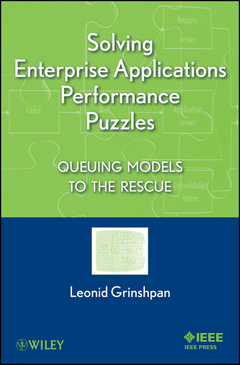Solving Enterprise Applications Performance Puzzles Queuing Models to the Rescue
Auteur : Grinshpan Leonid

Acknowledgments ix
Preface xi
1. Queuing Networks as Applications Models 1
1.1. Enterprise Applications—What Do They Have in Common? 1
1.2. Key Performance Indicator—Transaction Time 6
1.3. What Is Application Tuning and Sizing? 8
1.4. Queuing Models of Enterprise Application 9
1.5. Transaction Response Time and Transaction Profile 19
1.6. Network of Highways as an Analogy of the Queuing Model 22
Take Away from the Chapter 24
2. Building and Solving Application Models 25
2.1. Building Models 25
Hardware Specification 26
Model Topology 28
A Model’s Input Data 29
Model Calibration 31
2.2. Essentials of Queuing Networks Theory 34
2.3. Solving Models 39
2.4. Interpretation of Modeling Results 47
Hardware Utilization 47
Server Queue Length, Transaction Time, System Throughput 51
Take Away from the Chapter 54
3. Workload Characterization and Transaction Profiling 57
3.1. What Is Application Workload? 57
3.2. Workload Characterization 60
Transaction Rate and User Think Time 61
Think Time Model 65
Take Away from the Think Time Model 68
Workload Deviations 68
“Garbage in Garbage out” Models 68
Realistic Workload 69
Users’ Redistribution 72
Changing Number of Users 72
Transaction Rate Variation 75
Take Away from “Garbage in Garbage out” Models 78
Number of Application Users 78
User Concurrency Model 80
Take Away from User Concurrency Model 81
3.3. Business Process Analysis 81
3.4. Mining Transactional Data from Production Applications 88
Profiling Transactions Using Operating System Monitors and Utilities 88
Application Log Files 90
Transaction Monitors 91
Take Away from the Chapter 93
4. Servers CPUs and Other Building Blocks of Application Scalability 94
4.1. Application Scalability 94
4.2. Bottleneck Identification 95
CPU Bottleneck 97
CPU Bottleneck Models 97
CPU Bottleneck Identification 97
Additional CPUs 100
Additional Servers 100
Faster CPUs 100
Take Away from the CPU Bottleneck Model 104
I/O Bottleneck 105
I/O Bottleneck Models 106
I/O Bottleneck Identification 106
Additional Disks 107
Faster Disks 108
Take Away from the I/O Bottleneck Model 111
Take Away from the Chapter 113
5. Operating System Overhead 114
5.1. Components of an Operating System 114
5.2. Operating System Overhead 118
System Time Models 122
Impact of System Overhead on Transaction Time 123
Impact of System Overhead on Hardware Utilization 124
Take Away from the Chapter 125
6. Software Bottlenecks 127
6.1. What Is a Software Bottleneck? 127
6.2. Memory Bottleneck 131
Memory Bottleneck Models 133
Preset Upper Memory Limit 133
Paging Effect 138
Take Away from the Memory Bottleneck Model 143
6.3. Thread Optimization 144
Thread Optimization Models 145
Thread Bottleneck Identification 145
Correlation Among Transaction Time, CPU Utilization, and the Number of Threads 148
Optimal Number of Threads 150
Take Away from Thread Optimization Model 151
6.4. Other Causes of Software Bottlenecks 152
Transaction Affinity 152
Connections to Database; User Sessions 152
Limited Wait Time and Limited Wait Space 154
Software Locks 155
Take Away from the Chapter 155
7. Performance and Capacity of Virtual Systems 157
7.1. What Is Virtualization? 157
7.2. Hardware Virtualization 160
Non-Virtualized Hosts 161
Virtualized Hosts 165
Queuing Theory Explains It All 167
Virtualized Hosts Sizing After Lesson Learned 169
7.3. Methodology of Virtual Machines Sizing 171
Take Away from the Chapter 172
8. Model-Based Application Sizing: Say Good-Bye to Guessing 173
8.1. Why Model-Based Sizing? 173
8.2. A Model’s Input Data 177
Workload and Expected Transaction Time 177
How to Obtain a Transaction Profile 179
Hardware Platform 182
8.3. Mapping a System into a Model 186
8.4. Model Deliverables and What-If Scenarios 188
Take Away from the Chapter 193
9. Modeling Different Application Configurations 194
9.1. Geographical Distribution of Users 194
Remote Office Models 196
Users’ Locations 196
Network Latency 197
Take Away from Remote Office Models 198
9.2. Accounting for the Time on End-User Computers 198
9.3. Remote Terminal Services 200
9.4. Cross-Platform Modeling 201
9.5. Load Balancing and Server Farms 203
9.6. Transaction Parallel Processing Models 205
Concurrent Transaction Processing by a Few Servers 205
Concurrent Transaction Processing by the Same Server 209
Take Away from Transaction Parallel Processing Models 213
Take Away from the Chapter 214
Glossary 215
References 220
Index 223
Leonid Grinshpan Ph.D. (Stamford, CT) has been working for Oracle Corporation for more than 14 years as Consulting Technical Director. His customers include Dell, Citibank, Verizon, Clorox, Bank of America, AT&T, Best Buy, Aetna and many other major enterprises. He obtained Ph.D. in queuing models of computer systems from Russian Academy of Science.
Date de parution : 02-2012
Ouvrage de 256 p.
15.7x23.6 cm
